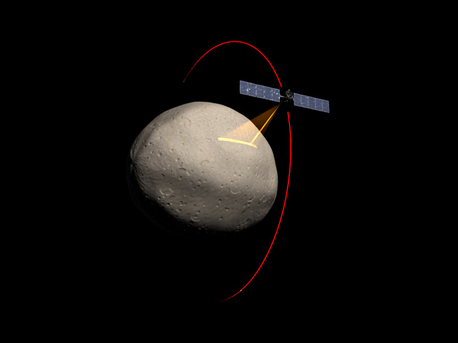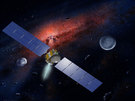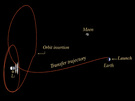Vesta - an asteroid in 3D
Dawn spacecraft orbiting Vesta
 © NASA/JPL
|
NASA's Dawn spacecraft, powered by ion propulsion, is carrying three different instruments to the main asteroid belt between Mars and Jupiter. Alongside a spectrometer from the Italian space agency (Agencia Spaziale Italia; ASI) and a gamma ray and neutron detector from the Los Alamos National Laboratory, is a German camera system, referred to as a 'framing camera', on board.
- » 1 - Test run for the arrival of the Dawn spacecraft in the asteroid belt
- » 2 - Bulges and indentations: a picture of Vesta
Test run for the arrival of the Dawn spacecraft in the asteroid belt
Pieces of asteroids found on Earth
Principally in the Sahara and the Antarctic, explorers have come across meteorites whose chemical compositions match the components of Vesta. This is what the spectral analyses of the meteorites and of Vesta suggest. "We are fairly sure that we have samples of Vesta here on Earth," says Jaumann. Planetary research scientists believe that, at some time in the past, another asteroid collided with Vesta, resulting in a 13-kilometre-deep crater on Vesta along with 50 new small asteroids, with numerous tiny fragments finding their way to Earth. So far, of the multitude of meteorites found on Earth, only a few can be classified as belonging to the Moon, Mars and Vesta; the origin of others remains uncertain. The fact that some samples can clearly be classified as originating from Vesta is a stroke of luck for Solar System research.Vesta - an asteroid in 3D
Dawn spacecraft orbiting Vesta
 © NASA/JPL
|
NASA's Dawn spacecraft, powered by ion propulsion, is carrying three different instruments to the main asteroid belt between Mars and Jupiter. Alongside a spectrometer from the Italian space agency (Agencia Spaziale Italia; ASI) and a gamma ray and neutron detector from the Los Alamos National Laboratory, is a German camera system, referred to as a 'framing camera', on board.
- » 1 - Test run for the arrival of the Dawn spacecraft in the asteroid belt
- » 2 - Bulges and indentations: a picture of Vesta







